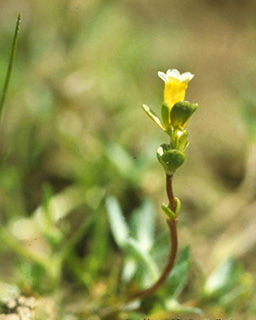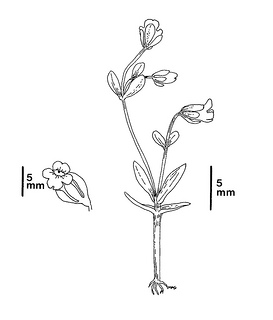(Gratiola heterosepala)
 Gratiola heterosepala. Photo © CNPS.
Gratiola heterosepala. Photo © CNPS.
 Gratiola heterosepala. CDFW illustration by Mary Ann Showers. (Click to enlarge)
Gratiola heterosepala. CDFW illustration by Mary Ann Showers. (Click to enlarge)
Boggs Lake hedge-hyssop is a California endangered plant species, which means that killing or possessing the plant is prohibited by the California Endangered Species Act (CESA). Boggs Lake hedge-hyssop occurs in California’s Central Valley, inner north coast range and Sierra Nevada foothills, but the largest concentration of occurrences are located within the Modoc Plateau. Boggs Lake hedge-hyssop is also known from one occurrence in Oregon. The species is restricted to clay soils in or near shallow water such as at the margins of lakes and vernal pools, and blooms April through September. After Boggs Lake hedge-hyssop was first described in 1954 it was known from only a few occurrences, but more recent surveys have located many additional populations. At the time of this page’s posting, the California Natural Diversity Database reports 86 occurrences of Boggs Lake hedge-hyssop that are presumed to still exist in California.
Boggs Lake hedge-hyssop has probably been most impacted in the past by habitat loss and fragmentation resulting from development and conversion of land for agriculture and other purposes, but it is unknown if the species’ current uneven distribution is due to natural or artificial factors. Development, infrastructure construction and other intensive land uses continue to threaten remaining populations of Boggs Lake hedge-hyssop. Grazing, trampling, and competition with invasive species such as Medusa-head grass may also be significant threats. The small and isolated populations of Boggs Lake hedge-hyssop are also especially vulnerable to extirpation from random events, and the species may also be vulnerable to the effects of climate change.
The U.S. Fish and Wildlife Service released a Recovery Plan for Vernal Pool Ecosystems of California and Southern Oregon in 2005, which includes Boggs Lake hedge-hyssop. The U.S. Forest Service and the U.S. Bureau of Land Management also released a formal conservation strategy for Boggs Lake hedge-hyssop in 1994 for lands they administer in northeastern California. More than half of Boggs Lake hedge-hyssop occurrences are on federal land, which does not necessarily mean that they will be protected from future disturbance, and several occurrences are protected in nature reserves. Actions to be undertaken to conserve Boggs Lake hedge-hyssop include protecting and managing unprotected populations and investigating and managing the threats to the species from grazing, trampling, invasive species, and other factors.
CDFW may issue permits for Boggs Lake hedge-hyssop pursuant to CESA, and you can learn more about the California laws protecting Boggs Lake hedge-hyssop and other California native plants. Populations of Boggs Lake hedge-hyssop occur in CDFW's Northern Region, North Central Region, Bay Delta Region, and Central Region. More information is also available from the United States Fish and Wildlife Service Species Profile for Boggs Lake hedge-hyssop.
Updated 3/19/2013